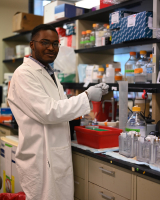Development of Novel Allosteric Activators of PP2A for Pediatric Cancers

Mentor: Dr. Alfred Thomas Look
For the past two years, we have worked to separate the ability of perphenazine (PPZ) to activate protein phosphatase 2A (PP2A) and kill leukemia cells from its effects on dopamine receptors that lead to dose-limiting toxicity. By combining biochemical reporter assays that assess the activities of a panel of PPZ-related compounds, we have succeeded in identifying an improved heterocyclic activator of PP2A (iHAP1), an analogue of PPZ, as 10 times more potent as a PP2A activator with no inhibitory activities on dopamine signaling. Experiments in T-ALL model mice have shown impressive antitumor activity of iHAP1 without causing any detectable toxicities. As part of research recently submitted for publication, we have determined the primary substrate of PP2A activated by iHAP1 as MYBL2 transcription factor. MYBL2 is highly expressed in almost all tumor cells and needs to be phosphorylated on Ser241 for activation. When dephosphorylated, MYBL2 loses its transactivation activity and blocks the expression of genes required by leukemia cells to progress through the monopolarity stage of prometaphase, followed by apoptotic cell death. We will perform experiments to determine why T-ALL cells arrest and die in prometaphase of the cell cycle during treatment with iHAP1, while normal bone marrow cells continue to proliferate normally and maintain normal blood cell counts. Our central hypothesis is that normal cells can survive after iHAP1-mediated activation of PP2A and dephosphorylation of MYBL2 because they are able to slow down their cell cycle at the G1/S boundary and allow the proteins necessary for mitosis to accumulate despite impaired MYBL2 function, while T-ALL and other cancer cells lose the ability to slow their cell cycle and arrest and die when they attempt to undergo mitosis. The long-range goal of this project is by combining the insight we gain from these experiments with medicinal chemistry studies ongoing with our collaborators to identify a clinical candidate drug related to iHAP1 that can be advanced in an evidence-based fashion into Phase I clinical trials in children with cancer. One exciting aspect of our work is that PPZ, the prototype PP2A activator, has already been shown by others to have activity in models of human breast cancer, lymphoma, and lung cancer. Thus, our studies in childhood T-ALL and AML capitalize on optimal in vivo and in vitro systems for assessment of activity/toxicity relationships during drug discovery, but the eventual clinical candidate drug that we discover may have broad applicability to the treatment of other types of childhood cancers

